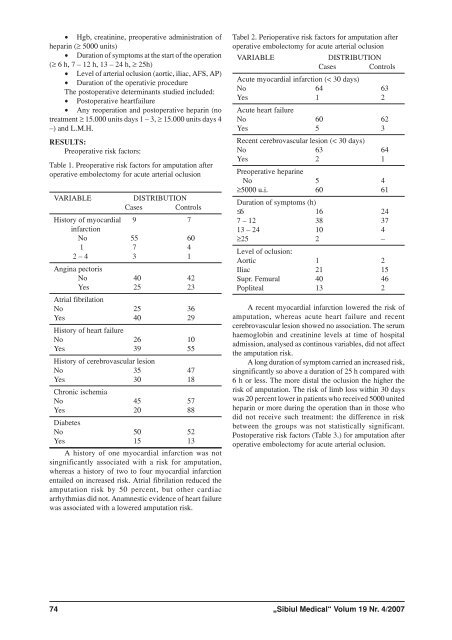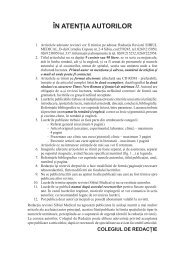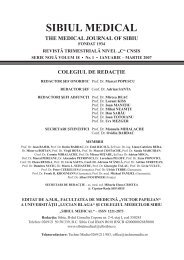Create successful ePaper yourself
Turn your PDF publications into a flip-book with our unique Google optimized e-Paper software.
• Hgb, creatinine, preoperative administration of<br />
heparin (≥ 5000 units)<br />
• Duration of symptoms at the start of the operation<br />
(≥ 6 h, 7 – 12 h, 13 – 24 h, ≥ 25h)<br />
• Level of arterial oclusion (aortic, iliac, AFS, AP)<br />
• Duration of the operativie procedure<br />
The postoperative determinants studied included:<br />
• Postoperative heartfailure<br />
• Any reoperation and postoperative heparin (no<br />
treatment ≥ 15.000 units days 1 – 3, ≥ 15.000 units days 4<br />
–) and L.M.H.<br />
RESULTS:<br />
Preoperative risk factors:<br />
Table 1. Preoperative risk factors for amputation after<br />
operative embolectomy for acute arterial oclusion<br />
VARIABLE<br />
DISTRIBUTION<br />
Cases Controls<br />
History of myocardial 9 7<br />
infarction<br />
No 55 60<br />
1 7 4<br />
2 – 4 3 1<br />
Angina pectoris<br />
No 40 42<br />
Yes 25 23<br />
Atrial fibrilation<br />
No 25 36<br />
Yes 40 29<br />
History of heart failure<br />
No 26 10<br />
Yes 39 55<br />
History of cerebrovascular lesion<br />
No 35 47<br />
Yes 30 18<br />
Chronic ischemia<br />
No 45 57<br />
Yes 20 88<br />
Diabetes<br />
No 50 52<br />
Yes 15 13<br />
A history of one myocardial infarction was not<br />
singnificantly associated with a risk for amputation,<br />
whereas a history of two to four myocardial infarction<br />
entailed on increased risk. Atrial fibrilation reduced the<br />
amputation risk by 50 percent, but other cardiac<br />
arrhythmias did not. Anamnestic evidence of heart failure<br />
was associated with a lowered amputation risk.<br />
Tabel 2. Perioperative risk factors for amputation after<br />
operative embolectomy for acute arterial oclusion<br />
VARIABLE DISTRIBUTION<br />
Cases Controls<br />
Acute myocardial infarction (< 30 days)<br />
No 64 63<br />
Yes 1 2<br />
Acute heart failure<br />
No 60 62<br />
Yes 5 3<br />
Recent cerebrovascular lesion (< 30 days)<br />
No 63 64<br />
Yes 2 1<br />
Preoperative heparine<br />
No 5 4<br />
≥5000 u.i. 60 61<br />
Duration of symptoms (h)<br />
≤6 16 24<br />
7 – 12 38 37<br />
13 – 24 10 4<br />
≥25 2 –<br />
Level of oclusion:<br />
Aortic 1 2<br />
Iliac 21 15<br />
Supr. Femural 40 46<br />
Popliteal 13 2<br />
A recent myocardial infarction lowered the risk of<br />
amputation, whereas acute heart failure and recent<br />
cerebrovascular lesion showed no association. The serum<br />
haemoglobin and creatinine levels at time of hospital<br />
admission, analysed as continous variables, did not affect<br />
the amputation risk.<br />
A long duration of symptom carried an increased risk,<br />
singnificantly so above a duration of 25 h compared with<br />
6 h or less. The more distal the oclusion the higher the<br />
risk of amputation. The risk of limb loss within 30 days<br />
was 20 percent lower in patients who received 5000 united<br />
heparin or more during the operation than in those who<br />
did not receive such treatment: the difference in risk<br />
between the groups was not statistically significant.<br />
Postoperative risk factors (Table 3.) for amputation after<br />
operative embolectomy for acute arterial oclusion.<br />
74 „<strong>Sibiul</strong> <strong>Medical</strong>“ Volum 19 Nr. 4/2007




